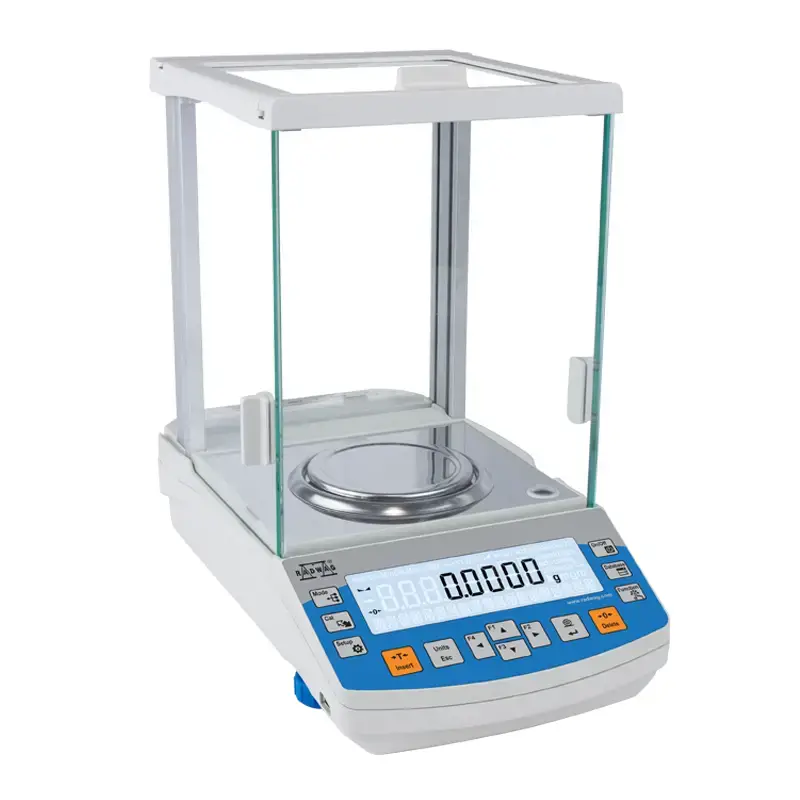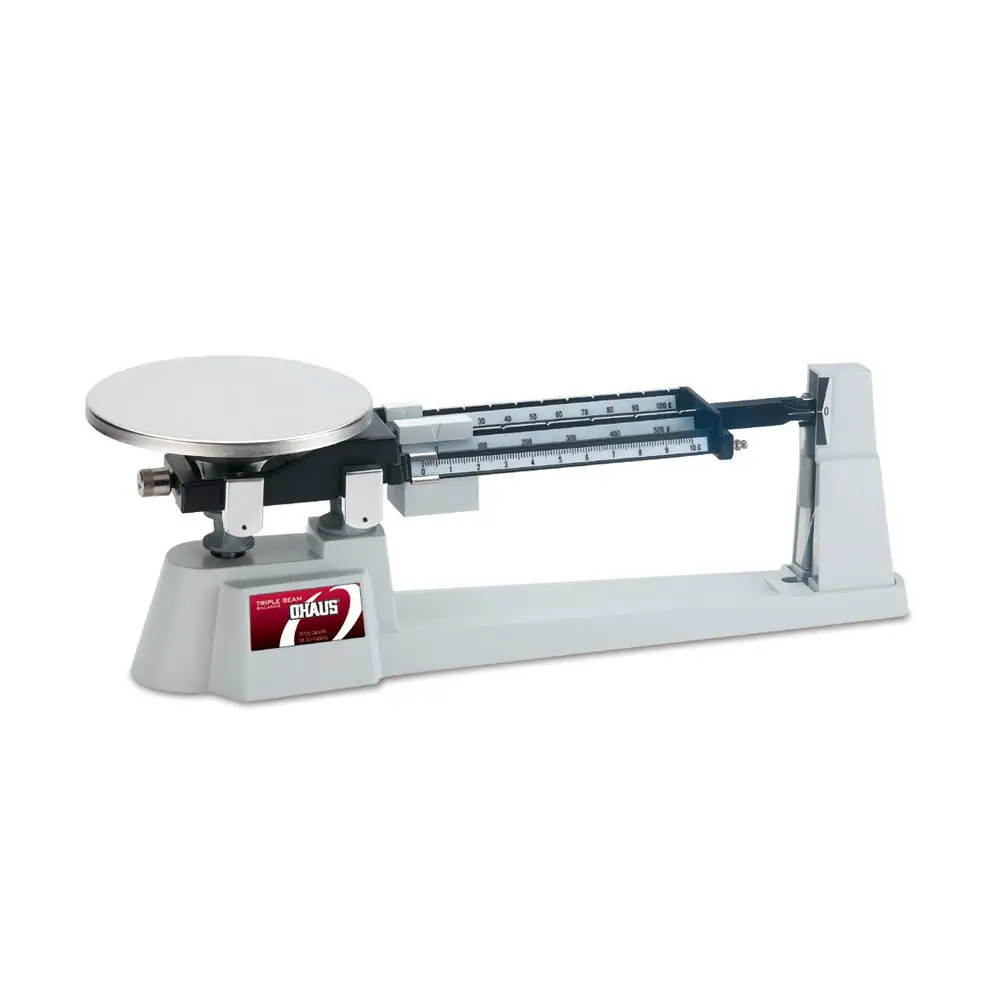What is Analytical balance?
- Analytical balance is a kind of very sensitive laboratory instrument, used for measuring mass of small quantities of materials. The accuracy usually reach up to 0.0001 g (0.1 mg).
- It works by balancing the sample mass against known weights or by electromagnetic force restoration method. In this type, the force needed to counteract the mass is measured, which gives very precise reading.
- The balance must be placed on a stable and vibration-free table, often inside an enclosed chamber, so that air movement or dust not affect the measurement.
- The weighing pan is usually small, made of metal or glass, and it’s protected by transparent doors to avoid disturbance. Even breath or little air movement can make wrong reading.
- Calibration is often done daily or before each use by using standard weights, sometimes automatic calibration system used also.
- Analytical balances are used widely in chemical labs, pharmaceutical industry, and research institutes for making standard solutions, weighing reagents, and quantitative analysis etc.
- It’s important that sample must be at room temperature before weighing, because warm objects can make air convection which give error in mass reading.

What is Triple beam balance?
- Triple beam balance is a kind of mechanical weighing device used for measuring the mass of objects with quite good precision, normally up to 0.01 g.
- It’s called “triple beam” because it has three beams, each with its own sliding weight (called rider). These riders moved along the beam to balance the mass on the pan.
- The first beam measures in grams (0–100 g), the second in tens of grams, and the third in tenths of grams. Altogether they give total mass when all rider positions are added.
- The balance must be zeroed before weighing, usually by adjusting a small knob at the end of the beam until the pointer lines up with the zero mark.
- A pan is attached to one end where the object is placed, and when the mass is unknown, the riders are moved until the pointer return to zero position again — that’s when it’s balanced.
- This type of balance doesn’t need electricity, it’s very sturdy and used mainly in schools, labs, and field works for quick and reliable measurement.
- Dust, vibration, and air current can disturb the reading a bit, so it must be used on a flat and stable surface.

Difference Between Analytical Balance Vs Triple Beam Balance
1. Precision – Analytical balance gives very high precision (up to 0.0001 g) while triple beam balance only measure till 0.01 g, so less sensitive comparatively.
2. Power Source – Analytical balance mostly works on electric / electronic system, but triple beam is manual, no electricity needed.
3. Principle of Working – Analytical type uses electromagnetic force restoration to measure mass, but in triple beam the balancing done mechanically by sliding riders on beams.
4. Structure – Analytical balance has enclosed chamber with glass doors to protect from air movement, whereas triple beam balance stay open and not enclosed.
5. Operation – In analytical type, reading displayed digitally on screen, but in triple beam you read manually by adding up positions of three riders.
6. Sensitivity to Environment – Analytical balance very sensitive to air, vibration, dust, temperature, etc., must be kept in controlled room; triple beam balance less affected, can use even on normal table.
7. Calibration – Analytical one mostly has automatic calibration, but triple beam needs manual zeroing every time before weighing.
8. Cost and Usage – Analytical balances are more expensive, used in research / pharma / chemical labs. Triple beam cheaper and found commonly in schools or teaching labs.
9. Construction Material – Analytical balances built with metal chamber, sensors, glass panels, while triple beam has metal base with three graduated beams and pan.
10. Readability – Analytical balance gives digital display directly; triple beam requires visual reading, which sometimes lead small human error.
| Feature / Point | Analytical Balance | Triple Beam Balance |
|---|---|---|
| Precision | Very high (up to 0.0001 g) | Moderate (around 0.01 g) |
| Power Source | Works electrically / digital | Fully manual, no electricity |
| Working Principle | Based on electromagnetic force restoration | Works by mechanical balancing using riders |
| Structure | Closed chamber (glass doors) | Open structure, no cover |
| Operation | Reading shown on digital display | Reading done manually by rider positions |
| Environmental Sensitivity | Highly sensitive to air, vibration, temp etc. | Less affected, can use on normal table |
| Calibration | Auto calibration system | Manual zeroing needed each time |
| Usage & Cost | Expensive, used in research / pharma labs | Cheaper, used in schools / teaching |
| Material Construction | Metal frame with sensors, glass enclosure | Metal base with 3 beams + pan |
| Readability | Digital, quick accurate | Manual, small human error possible |
Similarities between analytical and triple beam balances
1. Purpose – Both balances used for measuring mass of substances / objects accurately, mainly in labs or experimental setups.
2. Principle – Each type works on the comparison of known and unknown mass to reach a balance condition (equal weight both sides).
3. Calibration Need – In both instruments, zero adjustment is important before use to get correct reading.
4. Use in Laboratories – Analytical and triple beam both are common in educational and scientific laboratories for weighing chemicals, samples, etc.
5. Construction Material – Both have metal body and weighing pan, designed to hold objects safely during measurement.
6. Need for Stable Surface – Each one must be placed on a flat and vibration-free table, else reading may become wrong.
7. Dependence on Gravity – The working of both depends on gravitational force, so they give correct result only when properly leveled.
8. Maintenance Requirement – Both balances require cleaning and careful handling, since dust or fingerprints affect precision.
9. Measured Quantity – In both, the mass (not weight) is determined; so both are mass-measuring instruments.
10. Accuracy Factors – Air current, temperature change, and vibration affect both — though more in analytical one.
- Harris, D. C. (2015). Quantitative Chemical Analysis (9th ed.). W. H. Freeman and Company.
Encyclopedia Britannica. (2023). Analytical balance. Retrieved from https://www.britannica.com/technology/analytical-balance - Thermo Fisher Scientific. (2022). Principles of Analytical Balances. Retrieved from https://www.thermofisher.com
- Ohaus Corporation. (2023). Triple Beam Balance User Guide. Ohaus Instruments. Retrieved from https://www.ohaus.com
- Encyclopedia Britannica. (2022). Balance (instrument). Retrieved from https://www.britannica.com/technology/balance-instrument
- Text Highlighting: Select any text in the post content to highlight it
- Text Annotation: Select text and add comments with annotations
- Comment Management: Edit or delete your own comments
- Highlight Management: Remove your own highlights
How to use: Simply select any text in the post content above, and you'll see annotation options. Login here or create an account to get started.